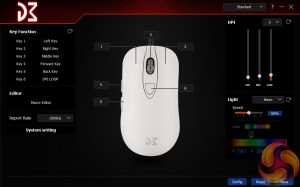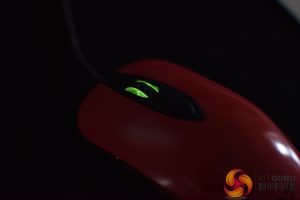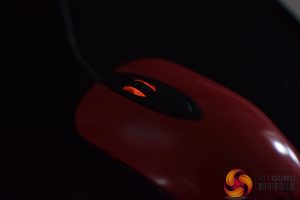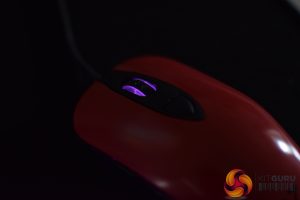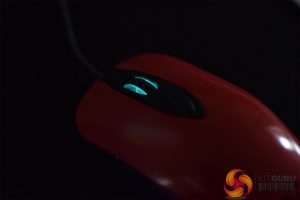To test the DM1 FPS, I used it as my daily driver for one week. We break down testing into four main sections: software, lighting, build quality and comfort, and performance.
Software
Unlike the original DM1 Pro, which had no software, the DM1 FPS does come with an additional software download. The mouse still works fine out of the box, so you don't have to use the software, but it lets you adjust DPI stages, lighting, polling rate, set macros and adjust button mapping.
Speaking of DPI stages, you can set up to 6 different stages and use the DPI cycle button to switch through them on the fly. However, in the software, DPI stages can only be adjusted in increments of 200 which is not very precise. Considering the PMW 3389 can adjust DPI in increments of 50, it feels a waste to have the software limit the increments to 200 instead. I spoke to Dream Machines about this and they told me that the software is still in beta, but they opted to release it with the launch of the FPS anyway so end-users have at least some control over the various settings. They hope to have this issue rectified shortly.
On the whole, the software is fine. It's nothing special, but everything is on a single page so it is easy to navigate, and I can't say it is missing any features. It's certainly better than no software.
Lighting
As mentioned on the previous page, the ‘DM' logo no longer illuminates – as it did with the Pro S – so the lighting boils down to the scroll wheel. Using software, you can choose between four options – static, breathing, neon (colour cycle), and off.
To cut to the chase, the LED is quite dim. In daylight, you will be hard pressed to know the LED is even on. At night time it is more visible, but the overall effect is certainly underwhelming. The colours look pretty good, it is just brightness which is the issue.
Still, I don't see this is a big problem for the DM1 FPS. You don't buy a mouse like this for the RGB lighting – you buy it for the shape, the sensor, the buttons. In my book, any lighting on a relatively niche mouse like this is an added bonus, so it wouldn't be fair to make it a big issue.
Build quality and comfort
Overall build quality of the FPS is impressive, despite it weighing just 83g. It's made from plastic, but the side and top sections don't creak or flex, and there is no discernible rattle when the mouse is shaken. It generally feels quite solid in the hand, which is definitely reassuring.
Unfortunately, Dream Machines did not take the opportunity to fix the side buttons, which as I pointed out in my review of the DM1 Pro S, are quite wobbly. This seems to be because they protrude from the side of the mouse a relatively long way – I think if they were more low-profile, the wobbliness issue would be lessened.
I did also notice a hint of pre-travel on the mouse's primary buttons. This is where the buttons depress slightly before a click is actuated, and it is generally an undesirable trait for a gaming mouse. The pre-travel isn't bad, but it is noticeable and can be just a little bit irritating.
Moving onto comfort, though, the DM1 FPS is wonderful to use day-to-day. As mentioned, it uses the classic Sensei shape – meaning it is symmetrical, with a more bulbous bottom end and a slight hump towards the back of the mouse as well. It measures 126 x 68 x 39 mm. Obviously, people have their own preferences when it comes to mice shape, but if you have used a Sensei or previous DM1 mouse, you will like the DM1 FPS.
Speaking personally, I used a claw grip throughout my time with the FPS as it is just a bit too flat for me to palm grip comfortably. If you have smaller hands, though, you could probably get away with it, and a fingertip grip isn't a problem either.
The glossy top shell on my ‘blood red' DM1 FPS also feels great. It is incredibly grippy and is a significant upgrade over the matte body of the Pro S. The matte Pro S feels slightly softer/smoother, which feels better against your skin, but as mentioned the glossy DM1 FPS simply gives much better grip, even when you get a little sweaty.
Performance
Moving onto performance, we'll start with the buttons – primarily, the difference between the DM1 FPS' Huano switches, and the DM1 Pro S' Omrons. Essentially, the Huanos are definitely a bit heavier and harder, with a bit more ‘snap' to them, while the Omrons feel a bit lighter and also more ‘springy'. I wouldn't say one is necessarily better than the other, but you will likely have your own preference.
The scroll wheel click on the FPS is noticeably better than the Pro S' scroll wheel, though. To recap, the FPS uses another Huano switch for the scroll wheel, while the Pro S uses a TTC switch for its wheel. To my mind, the FPS feels snappier and more tactile, while the Pro S is more mushy and indistinct.
The actual scrolling experience is the same, though, as the wheel itself has not been changed as far as I can tell. This is a slight shame as the wheel is not the best – the steps aren't very distinct, especially when you are scrolling quickly. It is not a huge issue, but I do feel it could be improved.
Now, coming to the sensor, I must confess I can't tell the difference between the PMW 3389 of the FPS, and the PMW 3360 of the Pro S. I used both at 1200 DPI and couldn't fault either – there was no acceleration, jitter or angle-snapping with either mouse. It could be that you have a preference, but in the real world both feel just as good as each other to my mind.
On the topic of the sensor, LOD is also worth noting. Using my cloth mousepad, I found the FPS would still track with one DVD wedged underneath, but once I added a second it stopped tracking. This is pretty standard for a mouse with no LOD control and shouldn't cause any issues.
Lastly, the cable. Or ‘shoelace', should I say. As a recap, the cable with the DM1 Pro S is not great – it is thick and quite inflexible. The FPS' cable, however, is fantastic – I would go as far to say it is the best stock cable I have ever used. Essentially, it just very light, soft and flexible – you can whip it around fast and it won't impede your movements or get kinked/twisted.
When not reviewing mice, I use a Logitech G403 with a custom Ceesa paracord cable. I don't think the DM1 FPS shoelace cable is quite as flexible – the Ceesa paracord really is quite incredible – but it is not a big difference at all. It is great to see Dream Machines take user feedback on-board and fit such a good cable to the DM1 FPS.
 KitGuru KitGuru.net – Tech News | Hardware News | Hardware Reviews | IOS | Mobile | Gaming | Graphics Cards
KitGuru KitGuru.net – Tech News | Hardware News | Hardware Reviews | IOS | Mobile | Gaming | Graphics Cards


